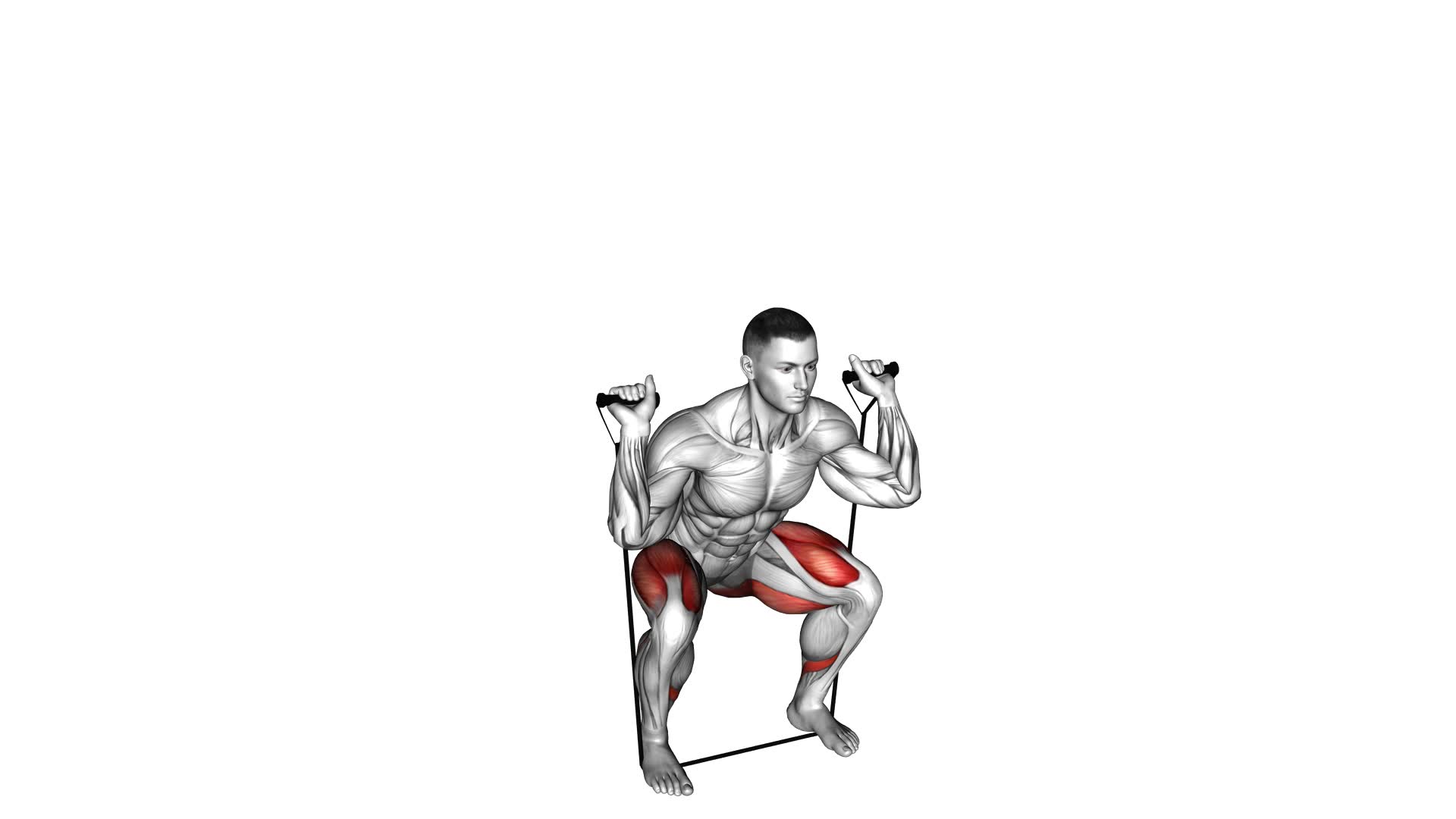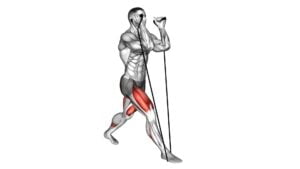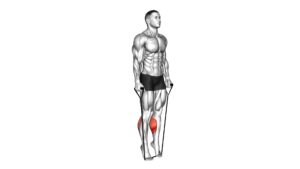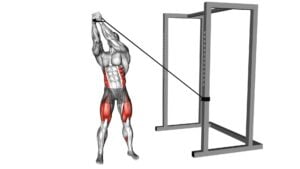Band Squat – Video Exercise Guide & Tips

Ready to take your workout to the next level?
Watch This Exercise Video
In this video exercise guide, we'll show you how to master the band squat.
With its numerous benefits and variations, this simple yet effective exercise will strengthen your lower body and improve your overall fitness.
Don't worry, we've got you covered with proper form and common mistakes to avoid.
Get ready to maximize your band squat workout and see results in no time.
Let's get started!
Key Takeaways
- Band squats target different muscle groups and can add variety to a workout routine.
- They increase intensity with resistance bands and strengthen lower body muscles.
- Band squats improve balance, stability, and help maintain proper form and technique.
- Breathing techniques and foot placement are important for stability and maximizing the effectiveness of the exercise.
Benefits of the Band Squat
You will frequently experience numerous benefits when performing the band squat exercise. Band squat variations allow you to target different muscle groups and add variety to your workout routine. With the use of band squat equipment, such as resistance bands, you can increase the intensity of the exercise and challenge your muscles in new ways.
One of the main benefits of band squats is that they help to strengthen your lower body muscles, including your quadriceps, hamstrings, and glutes. By incorporating different band squat variations, such as sumo squats or single-leg squats, you can specifically target these muscle groups and improve their strength and endurance.
In addition to building strength, band squats also help to improve your balance and stability. The resistance provided by the bands forces you to engage your core muscles and maintain proper form throughout the exercise. This not only enhances your overall stability but also helps to prevent injuries.
By performing band squats regularly, you can also improve your range of motion and flexibility in the lower body. The resistance from the bands helps to stretch and lengthen your muscles, increasing your overall mobility.
In the next section, we'll discuss the proper form for the band squat and provide tips on how to perform the exercise correctly to maximize its benefits.
Proper Form for the Band Squat
To perform the band squat with proper form, there are a few key points to keep in mind.
First, pay attention to your foot placement, ensuring that your feet are hip-width apart and pointing slightly outward.
Second, focus on maintaining proper alignment of your hips and knees throughout the movement to prevent injury.
Lastly, practice proper breathing techniques, engaging your core and exhaling as you push through your heels to stand back up.
Foot Placement Tips
For optimal form during the Band Squat, position your feet with precision. The correct foot position is crucial for maintaining balance and maximizing the effectiveness of the exercise.
Start by standing with your feet shoulder-width apart, toes slightly turned out. This stance allows for proper weight distribution and stability throughout the movement. Make sure to keep your weight evenly distributed between your toes and heels, avoiding putting too much pressure on either side.
Engage your core and maintain a straight back as you lower into the squat, keeping your knees in line with your toes.
Hip and Knee Alignment
Maintain proper hip and knee alignment during the Band Squat by ensuring that your hips and knees are in line with each other. Proper alignment is essential to prevent injuries and maximize the effectiveness of the exercise.
When performing the Band Squat, make sure your knees are directly above your ankles and facing the same direction as your toes. Avoid letting your knees collapse inward or push too far forward over your toes, as this can strain the knee joints.
Common errors include allowing the knees to cave in or tracking too far forward, which can put unnecessary stress on the joints.
Breathing Techniques for Stability
Breathe properly for stability during the Band Squat by focusing on your breath. Proper breathing techniques can enhance your stability and form while performing this exercise.
Here are some breathing exercises that can help improve your stability training:
- Diaphragmatic Breathing: Inhale deeply through your nose, filling your belly with air. Exhale slowly through your mouth, engaging your core muscles.
- Rhythmic Breathing: Inhale as you lower into the squat and exhale as you push back up. This helps synchronize your breath with the movement.
- 360-Degree Breathing: Imagine your torso as a balloon. Inhale, expanding the balloon in all directions, and exhale, deflating it. This promotes stability throughout your body.
- Breath Holds: Take a deep breath and hold it briefly at the bottom of the squat to engage your core and stabilize your body.
- Coordinated Breathing: Coordinate your breath with the resistance band's tension. Inhale as you prepare to squat and exhale as you push against the resistance.
Variations of the Band Squat
Now that you have mastered the proper form for the band squat, it's time to explore the different variations you can incorporate into your workout routine.
These variations include:
- Using different resistance bands to increase or decrease the intensity
- Experimenting with different techniques and forms to target specific muscle groups
- Exploring the muscle activation targets to customize your workout based on your goals
Resistance Band Options
Choose from various resistance band options to add variety and challenge to your band squat workout. Here are five resistance band exercises that can be used as modifications for the band squat:
- Banded Squat with Overhead Press: Loop the resistance band around your wrists and perform a squat while simultaneously pressing the band overhead.
- Banded Sumo Squat: Place the resistance band around your thighs, just above the knees, and perform a sumo squat.
- Banded Squat with Lateral Leg Lift: Loop the resistance band around your ankles and perform a squat while lifting one leg out to the side.
- Banded Squat with Pulse: Hold the resistance band at chest height and perform a squat while pulsing up and down.
- Banded Squat with Bicep Curl: Step on the resistance band with both feet and hold the handles, then perform a squat while curling your arms.
Incorporating these resistance band variations will help target different muscle groups and increase the intensity of your band squat workout.
Technique and Form
To continue the discussion from the previous subtopic on resistance band options, let's delve into the technique and form variations of the band squat.
When performing the band squat, it's important to maintain proper technique to maximize its effectiveness and avoid common mistakes. First, make sure to keep your feet shoulder-width apart and your knees aligned with your toes throughout the movement. As you descend into the squat, push your hips back and lower yourself until your thighs are parallel to the ground. Remember to engage your core and keep your chest lifted.
One important variation to consider is using different resistance bands to increase or decrease the challenge of the exercise.
Now that we've covered technique and form, let's move on to discussing the muscle activation targets.
Muscle Activation Targets
To maximize the effectiveness of the band squat and target different muscle groups, try incorporating various variations of the exercise. By modifying the band squat, you can activate specific muscles to achieve your fitness goals.
Here are some exercise modifications that target different muscle activation:
- Narrow stance squat: This variation targets the quadriceps and inner thigh muscles.
- Wide stance squat: This variation focuses on the glutes and outer thigh muscles.
- Pulse squat: Adding a pulse at the bottom of the squat engages the muscles for a greater burn.
- Single-leg squat: This modification targets the quadriceps, glutes, and stabilizing muscles.
- Band jump squat: Incorporating a jump with the band squat increases the activation of the leg muscles and improves explosive power.
By incorporating these variations, you can effectively activate different muscle groups and get the most out of your band squat workout.
Now let's move on to the equipment needed for the band squat.
Equipment Needed for the Band Squat
You will need specific equipment for performing the Band Squat exercise. The main equipment required is a resistance band. The resistance level of the band should be chosen based on your fitness level and strength. It's important to select a band that provides enough resistance to challenge your muscles, but not so much that it compromises your form or puts excessive strain on your joints.
When choosing a resistance band, consider your current strength and fitness level. If you're a beginner, start with a lighter resistance band and gradually increase the resistance as you get stronger. On the other hand, if you're more advanced, you can opt for a band with higher resistance to intensify the exercise.
To perform the Band Squat exercise safely, make sure to follow these precautions. First, ensure that the resistance band is securely anchored to a stable object, such as a squat rack or door anchor. This will prevent any unexpected movement or accidents during the exercise. Additionally, maintain proper form throughout the movement, keeping your back straight, chest up, and knees aligned with your toes. Lastly, start with a lighter resistance band before progressing to higher levels of resistance to avoid straining your muscles or causing injury.
Common Mistakes to Avoid During the Band Squat
When performing the Band Squat, it's important to be aware of common mistakes that should be avoided in order to ensure proper form and maximize the effectiveness of the exercise. Here are some common mistakes to watch out for:
- Allowing the knees to cave in: It's important to keep your knees in line with your toes throughout the movement. Letting them cave in can put unnecessary stress on the knees and compromise your form.
- Arching the lower back: Maintaining a neutral spine is crucial during the Band Squat. Avoid arching your lower back as it can lead to back pain and potential injury.
- Not engaging the core: Your core muscles play a significant role in stabilizing your body during the squat. Failing to engage your core can result in poor form and diminished results.
- Holding your breath: Proper breathing techniques are essential during any exercise, including the Band Squat. Remember to inhale as you lower down and exhale as you push back up.
- Not going deep enough: Partial squats limit the engagement of your muscles. Aim to squat down until your thighs are parallel to the ground, ensuring a full range of motion.
By avoiding these common mistakes, you can optimize your Band Squat workout and reduce the risk of injury.
Now, let's move on to some tips for maximizing your band squat workout.
Tips for Maximizing Your Band Squat Workout
Maximize your Band Squat workout by incorporating these tips.
To achieve the best results, it's important to dispel some common misconceptions. Firstly, don't be afraid to use resistance bands of varying strengths. By gradually increasing the tension, you'll challenge your muscles and maximize your results.
Secondly, focus on maintaining proper form throughout the exercise. Keep your back straight, chest lifted, and knees aligned with your toes. This will engage the correct muscles and prevent injury. Additionally, make sure to engage your core by tightening your abdominal muscles. This will provide stability and support during the movement.
Another tip is to control the descent and ascent of the squat. Avoid rushing through the exercise and instead, focus on the quality of each repetition.
Lastly, don't forget to breathe! Inhale as you lower your body and exhale as you push back up.
Frequently Asked Questions
What Are Some Alternatives to the Band Squat for Targeting the Same Muscle Groups?
Looking for alternative exercises that target the same muscle groups as the band squat? There are a few options you can try.
One alternative is the goblet squat, which also works your quadriceps, hamstrings, and glutes.
Another option is the barbell squat, a classic exercise that targets similar muscle groups.
Both of these exercises can provide similar benefits to the band squat, such as improving lower body strength and stability.
Give them a go and see what works best for you!
Can the Band Squat Help Improve Flexibility in the Lower Body?
The band squat is a great exercise for improving lower body flexibility. By incorporating resistance bands, you can add extra tension to your squats, which helps to stretch and strengthen your muscles. This exercise primarily targets your quadriceps, hamstrings, and glutes, but it also engages your hip flexors and calves.
The band squat not only improves lower body strength, but it also increases your range of motion and overall flexibility in the lower body.
How Can the Band Squat Be Modified for Individuals With Knee or Hip Issues?
To modify the band squat for knee or hip issues, start by placing a chair behind you for support. This will reduce the strain on your joints.
Another option is to use a resistance band with lighter tension to decrease the load on your knees and hips.
The band squat can be beneficial for rehabilitation as it strengthens the muscles surrounding the knee and hip joints. This can help improve stability and reduce pain in those areas.
Is It Necessary to Use a Resistance Band for the Band Squat, or Can Other Types of Equipment Be Used?
You don't necessarily need a resistance band for the band squat. There are alternative equipment options that you can use. However, the band adds an extra level of resistance and challenges your muscles in a different way.
It's recommended to use a resistance band to get the full benefits of the exercise.
That being said, if you don't have a band, you can still perform variations of the band squat using other equipment or bodyweight exercises.
How Often Should the Band Squat Be Incorporated Into a Workout Routine for Optimal Results?
To get the best results from the band squat, it's important to know how often to incorporate it into your workout routine.
The frequency of band squat sessions will depend on your fitness goals and overall training program.
It's recommended to include the band squat at least 2-3 times a week for optimal results.
Additionally, adding variations to your band squat routine can help target different muscle groups and keep your workouts challenging and effective.
Conclusion
In conclusion, the band squat is a highly effective exercise for strengthening the lower body. By incorporating resistance bands, you can increase the intensity and target specific muscle groups. Remember to maintain proper form and avoid common mistakes to maximize the benefits of this exercise.
With the right equipment and technique, you can achieve great results and improve your overall fitness. So grab your resistance bands and get squatting!

Author
Years ago, the spark of my life’s passion ignited in my mind the moment I stepped into the local gym for the first time. The inaugural bead of perspiration, the initial endeavor, the very first surge of endorphins, and a sense of pride that washed over me post-workout marked the beginning of my deep-seated interest in strength sports, fitness, and sports nutrition. This very curiosity blossomed rapidly into a profound fascination, propelling me to earn a Master’s degree in Physical Education from the Academy of Physical Education in Krakow, followed by a Sports Manager diploma from the Jagiellonian University. My journey of growth led me to gain more specialized qualifications, such as being a certified personal trainer with a focus on sports dietetics, a lifeguard, and an instructor for wellness and corrective gymnastics. Theoretical knowledge paired seamlessly with practical experience, reinforcing my belief that the transformation of individuals under my guidance was also a reflection of my personal growth. This belief holds true even today. Each day, I strive to push the boundaries and explore new realms. These realms gently elevate me to greater heights. The unique combination of passion for my field and the continuous quest for growth fuels my drive to break new ground.







